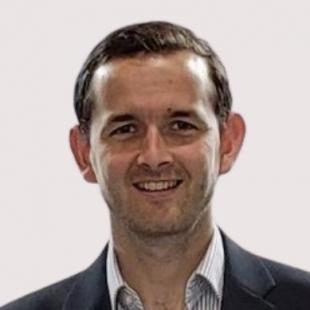Current role
After graduating from IDCORE, Laurie joined JBA Consulting, an organisation he had been attracted to by seeing them present at an IDCORE company day. He is now based in Wallingford where he manages the development of their ForeCoast® Marine consultancy tool. It is a tool that is used for assessing project feasibility and weather risk for offshore wind installations.
His time is split roughly equally between product development, consultancy, business development and client support. His clients include one of the current IDCORE research engineers.
Why IDCORE
Laurie originally applied to join IDCORE because he wanted to contribute to the development of renewable energy and in particular nascent technologies like wave power. He liked the idea of research but felt that a PhD was maybe too academic - he wanted a work on something that had a material impact in the sector and thought this was more likely to happen within the context of an engineering doctorate.
Quote: Laurie Wilkinson, Senior Metocean Analyst, JBA Consulting
‘I came to IDCORE having completed a BEng in Environmental Engineering along with a number of renewable energy related internships, including some time spent at the Centre for Alternative Technology in Wales and HR Wallingford (not far from where I am now based). Through these experiences I had developed an interest in coastal engineering and programming, which I am still pursuing today.
IDCORE allowed me to secure a career in this area - it gave me a broad knowledge of the offshore renewable energy industry, including mechanical and electrical engineering - a good practical background that supports my current role. It taught me how to analyse metocean data, and introduced me to the design and testing of physical devices and the challenges of practical system operation. Perhaps most importantly, it helped me to understand the clients I now work with on a daily basis.
However, my most abiding memory of my time at IDCORE was the satisfaction of getting a physical model of the system I had designed into a wave tank and getting everything working. My work delivered a significant advance in the design of power take off systems and the physical model I developed has subsequently been used by other researchers studying array effects.’
Project
Throughout his project, Laurie worked with Aquamarine Power at their base in Queens University, Belfast. He worked on a new version of their ‘Oyster’ device, which had a modular design to help reduce physical loads on the flap and foundation and facilitate installation with smaller boats. He chose to work with them because he liked their device. It was a simple, mechanically reliable design that looked efficient, and at the time (2013) they were at the forefront of the industry.
The majority of the project was focussed on physical experimentation in a wave laboratory - designing a scale model of the new device and then gathering data and analysing the outputs of wave tank tests.
Laurie’s work compared the modular device with the original ‘rigid’ design, finding that it led to some reduction in the forces applied to the foundation, but with mixed results on power – it performed better in angled waves than those approaching the device head on.
He learned a lot from the project, not least how easy it is to over-complicate device design.







